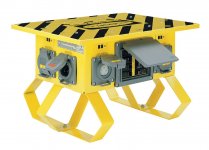Most Manuals that come with the portable power tools I've purchased, have a chart towards the front that lists power cord gauge requirements, for different amperage levels, over different distances. For some reason the charts have never been customized for the individual tool the manual was for. The charts tend to vary a bit about how specific they are, but there is one thing that almost all the charts have been specific about.
To run a 15 amp power tool over a 100 foot extension cord, you should use a 10/3 gauge extension cord at the minimum.
I just checked the manual for my Porter Cable biscuit joiner. For a tool spec'd at 14-16 amps, 10 gauge was listed as recommended for a 100 foot cord. At 150 foot the cord recommendation went to 8 gauge. When you get to 200 and 250 feet, 6 gauge was recommended. For 300 and 400 foot cords 4 gauge was recommended, and for 500 foot cords 2 gauge was recommended.
Of the manuals I checked, Porter cable seems to have the charts that are larger and more specific. I checked an older Milwaukee drill manual, and Milwaukee seems to have less specifics, but was more conservative with extension cord recomendations. Milwaukees chart recommended 10 gauge at 75 feet for tools between 12.1 and 16 amps. For tools between 16.1 and 20 amps their chart stopped at 10 gauge over 50 feet.
Since the tools companies manufacture the tools, I presume they may have a better understanding of what kind of problems such as spike voltage, drop voltage, and duration of use could have on there tools, in regards to safety issues, and the performance and longevity of the tools.
I've never seen a regular extension cord bigger than 10/3. I presume if you want something bigger you wood have to look into purchasing wire and adding your own aftermarket plugs, or purchase heavier cords like the kind used for theatrical use, and purchase or make an adapter for regular 15 amp plugs.
If you wanted to go one gauge step below what is recommended, or slightly longer than what us recommended you probably would have an issue for sporadic use, since most tools don't operate at full amperage continuously.
In case you're wondering, after reading the charts I mostly only buy 10 gauge cords. I do have a couple lighter gauge cords for working at the top of ladders since I'm usually not using 15 amp tools in those situations, and the lighter cords are less of a hassle.



